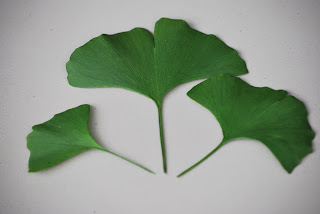Plant geneology
I had intended to do this blog on the Ginkgo tree, but quickly realized that without telling it's history, the full depth of this wonderful tree would be lost. I also realized how interconnected it was and is to it's closest relatives, that telling the Ginkgo's story without mentioning it's "cousins" is like telling of my life without mentioning my family. Just as we can trace back our families through genealogy, we can also trace plants through fossils that have been discovered, writings of civilizations and through the system of classification that we have devised to try to understand the living beings we share this Earth with.
There are many different types of plants in the plant kingdom, but what we'll be focusing on is the seed bearing plants. Within the superdivision of the seedbearing plants are 5 separate divisions.....the conifers, cyads, ginkgo, gnetophyta and the magnoliophyta. Of the 5, the first 4 are classified as gymnosperms or naked seed (think pine cones). The magnoliophyta are the angiosperm, otherwise known as the flowering plants.
Now we travel far, far, far back to the Permian period which was 248 to 290 million years ago. This was before the dinosaurs, this was before the land masses look as they do today, this was way before our flowering plants. This was the era that we take the conifers, cycads and ginkgo's back to. That's old! Up until this time, the earth was mostly inhabited by spore producing plants with just a few seed producing ferns. Of the gymnosperms, the cycads were numerous at this time..today there are around just 300 species left. The sago palm being the most known. The cycads grow in the more tropical areas. Of the three, the conifers are the trees we most associate with now. The pines, spruces, firs, redwoods, sequoias. There are around 630 species of the conifers. For millions of years the conifers were the vast majority of the plant life here on earth, before the flowering plants arrived on the scene. It's hard to imagine while looking out at the woods today, that these trees have been on this earth for so long. The ginkgo tree heavily populated the earth at this time also and was a major plant with many species for at least another 150 million years. Scientist believe that it grew along the banks of water and with the angiosperms becoming the dominant class, the ginkgo could not compete. Today, there are only 2 species left.
So now we've got a little background to go by. Scientist believe the ginkgo is closer related to the cycads than the conifers, although there are still many opinions on that. The population of the tree declined from environmental factors over millions of years, until they were thought to be extinct. They were found to be growing by Chinese monks for over a period of 1,000 years in central China. They think the ginkgo survived all the climate changes, volcanic activity and land readjustment because China was a quieter spot of activity. There are trees that are 2500-3000 years old still growing in China today. They were then reintroduced to the west around 1690 from trees growing in Japan.
Ginkgo biloba is the main species we grow today. Biloba means two lobed in reference to the leaves. The leaves are thought to have been made up of needles, like the evergreens, but fused together to make one leaf. The tree is also called the maidenhair tree because the leaves resemble those of the maidenhair fern. The leaves are deciduous, another way they are different than conifers, and turn a beautiful yellow in the fall. They say the leaves fall all at once and form a circle of yellow under the tree. The ginkgo is slow growing and can eventually reach up to 115 feet tall. It benefits the tree greatly to give it a drink of water while it's young, as their first habitat was by stream banks. The trees are either male or female. The female does not produce fruit until it is at least 30 - 40 years old. The male fertilizes by pollen cones that release pollen which the wind carries to the female and if all goes right , the pollen lands on a pollination droplet which carry the sperm into the plant and the sperm swims to the ovule to fertilize it. The ginkgo and cycads are the only 2 plants that have free swimming sperm. This is an ancient way for fertilization that at first was common in the ocean before land plants. The "fruits" of the female ginkgo have a horrible smell when they drop, which is why mostly the males are planted today. The pulp is washed off... wear gloves!...and the seed is left to dry. The seeds are still eaten by the Chinese.
The ginkgo is the national tree of China and is called either yajiao (duck feet) or baiguo (white nut). The word Ginkgo comes from Japan. The trees are very tolerant to pollution and resistant to pest. Ginkgo trees survived the blast at Hiroshima and are still alive today. One reason scientist think it was able to withstand the changes of the earth through it's long history.
It is absolutely amazing that we still have these plants with us today, considering so many species have become extinct over these millions of years. To be able to plant one in the garden or watch them grow in the woods, is one of the wonders of nature. It is to our benefit to protect them all.... ginkgo, conifers and cycads.... and help them flourish when so much is going against them. Their lives and ours will be all the better for it.





Comments
http://davesgarden.com/guides/articles/view/227/